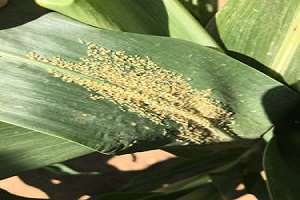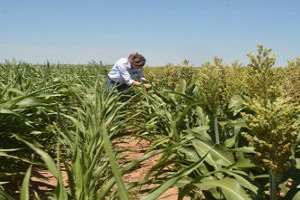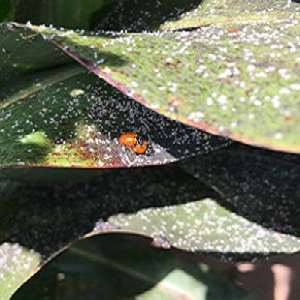Sorghum producers can reduce input costs and improve their bottom line in the battle against sugarcane aphids in the Texas High Plains through the use of selected varieties and early planting and scouting, according to a Texas A&M AgriLife Research study.

Dr. Ada (ah da) Szczepaniec (Stra PA netz), AgriLife Research entomologist in Amarillo, has wrapped up her first year of assessing the impact of planting dates, insecticide seed treatments and resistant varieties of sorghum on the timing and severity of sugarcane aphid infestations in a study near Bushland.
“We demonstrated that use of a sorghum hybrid with tolerance to sugarcane aphids has significant economic benefits because it slows down the growth of the sugarcane aphid population and thus can decrease costs of managing these pests when only one well-timed application of insecticides is needed,” Szczepaniec said.
She said this first year of study also suggests producers can decrease input costs by eliminating expenses on insecticide seed treatments to suppress sugarcane aphids if they plant sorghum early.
But, she added, neither hybrid selection nor insecticide seed treatment eliminates the need for scouting early and often once reports of sugarcane aphid presence in the region emerge. Data collected suggests a focused effort to scout early will help in making well-timed foliar insecticide applications to provide control.
In her study, Szczepaniec evaluated the effect of planting date – early or traditional; sorghum varieties – susceptible or tolerant; and neonicotinoid seed treatments – treated and untreated, on the rate of increase and abundance of sugarcane aphids and sorghum yield.

The protocol included detailed counts of sugarcane aphids once plots were colonized and foliar insecticide applications when aphid numbers reached the 50-125 aphids-per-leaf threshold used in South Texas.
Because little research has been conducted on sugarcane aphid thresholds in the High Plains, she said the already established threshold guidelines from South Texas were used and were effective.
“We suppressed the aphids with an application of a foliar insecticide, and their numbers were very low for three to four weeks after treatments,” Szczepaniec said.
However, she said, based on the first year of data it appears the population increase of sugarcane aphids in the High Plains is much quicker than in South Texas. Only two weeks after colonization, the susceptible hybrid reached or exceeded the threshold of 50-125 sugarcane aphids per leaf.
The tolerant hybrids offered about an additional week of time before thresholds were exceeded, Szczepaniec said. The tolerant sorghum variety had significantly fewer aphids than the susceptible variety.
She said even when the early planted tolerant variety plots were not treated with foliar insecticides, the yield was comparable to the insecticide-treated plots.
“Insecticide seed treatments, on the other hand, offered some protection against aphids, but only in sorghum planted at the traditional planting date, and not in early planted sorghum,” Szczepaniec said.
Sugarcane aphids on the tolerant hybrid with insecticide seed treatments, particularly when it was planted at the traditional planting date, also did not reach the exponential population growth until approximately four weeks after colonization compared to three weeks on the susceptible hybrid.
“This is relevant because once the aphids reach this phase, it is extremely hard if not impossible to control them,” Szczepaniec said.
She said during the study they noted infestations were very uniform across the plots – once the aphids arrived, almost 100 percent of the plants had one or more aphids.

“We also did not note honeydew on plants before aphid numbers exceeded 150 per leaf. This means that looking at undersides of individual leaves to assess aphid numbers is likely to be key to spotting their densities before their populations explode.”
In the study, the numbers and diversity of aphid predators were relatively high even in plots that received foliar insecticide applications. Szczepaniec said it is not possible to estimate if these predators play a large enough role in suppressing aphids until additional data are collected, but their presence is highly desirable, especially after foliar insecticides are applied.
All plots were hand-harvested because using mechanical equipment to harvest the unsprayed plots would have resulted in harvesting issues and losses in yield, she said.
“It is important to note this is only one year of field data, and additional work is necessary to validate these outcomes. However, the early conclusions based on this research would be to scout often, especially at the end of July based on the 2015 and 2016 sugarcane aphid reports, and apply insecticides when thresholds are reached; use tolerant varieties of sorghum if they are agronomically sound for the area; and if sugarcane aphids are the key pest of concern early in the season, omit insecticide seed treatments when planting sorghum early.”
Click here to see more...